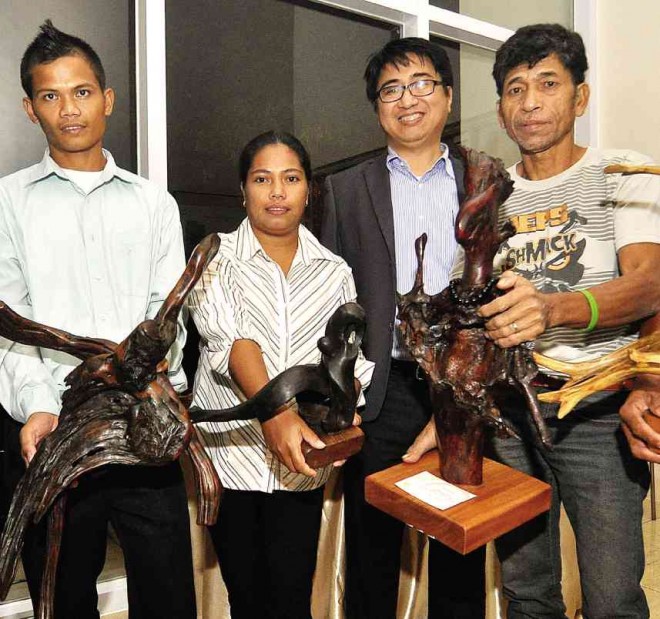
Instead of working against nature, sculptors from Quezon, Capiz, Palawan and the Ipo watershed chose to work with it, and produce rustic, one-of-a-kind art pieces made from aged driftwood.
Their works are on display at the Madrigal Business Park’s Sonria Pavilion in Alabang. Dubbed “Gising,” the month-long exhibit/sale is organized by Smart Communications, Inc. and partners. It will run until Aug. 31.
For fishermen of Banglos, a barangay in General Nakar, Quezon, the journey to become part-time sculptors began after a series of devastating floods and landslides hit the province in 2004.
Their success story became the template for Darwin Flores, Smart’s head of community partnership, and veteran sculptor Rey Contreras to replicate the program in seaside communities in Capiz and Palawan, which were devastated last year by Supertyphoon “Yolanda.”
A similar program was put in place among Dumagats, the indigenous people living in the Ipo watershed. A critical source of water supply for Metro Manila, the watershed is at the foot of Sierra Madre in Norzagaray, Bulacan.
Instead of relying on relief goods and cutting down trees to turn them into cheap charcoal, these people have regained their pride and adopted an alternative livelihood by acquiring a new skill that requires imagination.
Unlike in traditional sculpture, these folk artists work with the existing size, shape and form of the material.
They were taught by Contreras and the Daambakal Sculptors of Tondo to “go with the flow.”
“Rey encouraged them to enhance and not alter the wood’s natural appearance,” Flores said. “Since they’re fishermen, fish has become a favorite subject. Most of them see fish and other marine creatures in the pieces of wood in front of them.”
Manipulation is mostly limited to minimal shaping, polishing and adding grooves to certain areas to simulate, say, a fish’s tail and fins or a bird’s wings and feathers. For eyes, they stick a pair of black marbles.
Since they have patina and weathered look not found in newly cut wood, only pieces of driftwood found floating in the river or washed along riverbanks would do as main material for these sculptures.
Smart also gave each group initial tools such as chisels, drills, mallets and chainsaws.
Investing their earnings
Earning from their designs, a number of fishermen began buying their tools as their form of investment. Not a few used the extra income to buy nets and other fishing implements.
After a series of exhibits, including one at Cultural Center of the Philippines (CCP), the Banglos sculptors had earned more than P1 million within two years. A portion of the proceeds went back to the community.
They found a captive market of collectors and homeowners, especially condo dwellers, in need of interesting, unique and affordable artworks. Generous buyers even pay extra for pieces they fancy.
Many of these men were reluctant at first to do sculpture, said Flores. It took him and Contreras nearly two months to gather them for a meeting.
“I was initially tasked by my boss, Mon Isberto, to oversee a joint project with Gawad Kalinga to rebuild houses in Banglos,” he said. “That was early 2005. While I was there, I saw how people gathered driftwood to turn them into charcoal.”
A sack of charcoal, which takes at least three days to produce, barely yielded P85. This and the fact that there were too many people relying on dole-outs led Flores to think of alternative ways to help them earn extra income.
Going back to fishing was out of the question. Banglos’ rich fishing grounds, especially along the river’s delta, had been destroyed.
Before joining Smart, Flores was a handicraft buyer for Oxfam UK. He dealt with Contreras and the Daambakal sculptors. He lost no time calling Contreras after spotting the opportunity of turning driftwood into art pieces.
“Spotting the opportunity was easy,” he said. “The hard part was convincing the community to give the project a try. It was quite understandable because none of these fishermen were into art.”
Due to Flores’ insistence and perhaps because Smart was helping them rebuild their homes, the Banglos fishermen finally sat down with him and Contreras one afternoon in March 2005 to listen to what they had to say.
Contreras began by asking them: Can you see or form certain images when you stare at clouds? The same applies to driftwood.
He then introduced participants to different tools needed to shape objects from wood. He then called on volunteers to use each tool on actual driftwood.
Hooked
“We started the meeting soon after lunch,” said Flores. “By 2 p.m. they were already so engrossed in the workshop. When it was time to end at 5, they still didn’t want to go home. Ginanahan na! (They were all hooked!)”
That was on a Friday. When Flores and Contreras returned to Banglos from Manila on Monday to resume their talk, they were greeted with art pieces the fishermen had done over the weekend.
Less than a month later, the Banglos fishermen had their first exhibit in the Smart head office in Makati. They were able to generate more than P100,000.
In another exhibit four months later at CCP, they sold another P100,000 worth of sculptures.
One of their biggest exhibits happened much later in an event organized by the Food and Wine Society of the Philippines. In less than two hours, they generated P250,000 worth of sales.
“These guys clearly have a market for their artworks,” said Flores. “We hope to duplicate their success as we introduce the program to an Aeta community in Tarlac.”